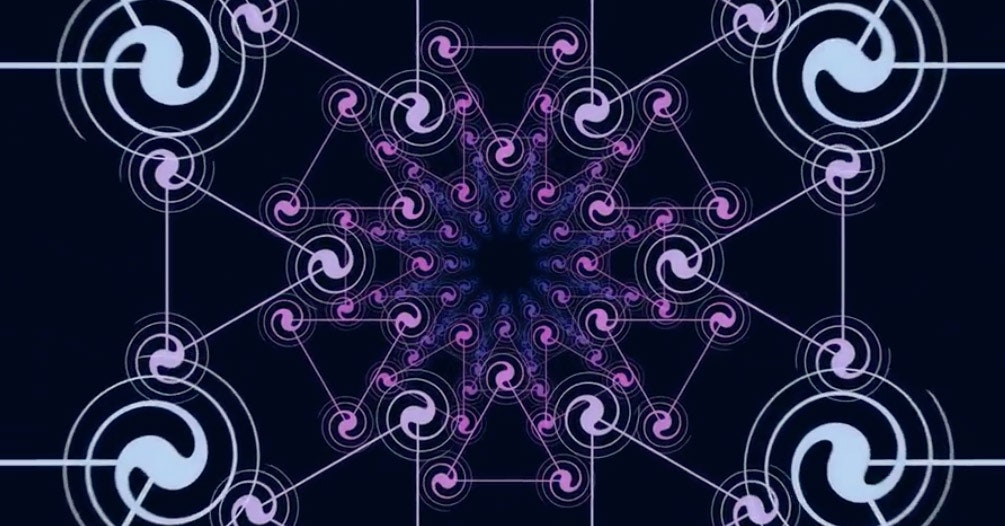
The universe started out quite smooth overall, the thinking goes, but quantum wiggles imprinted space with tiny dollops of extra matter. As space expanded, these dense spots stretched out even as the tiny ripples continued to arise. When inflation stopped, the young cosmos was left with dense spots ranging from small to large, which would go on to become galaxies and galaxy clusters.
All theories of inflation nail this two-point correlation function. To distinguish between competing theories, researchers need to measure subtler, higher-point correlations—relationships between the angles formed by a trio of galaxies, for instance.
Typically, cosmologists propose a theory of inflation involving certain exotic particles, and then play it forward to calculate the three-point correlation functions it would leave in the sky, giving astronomers a target to search for. In this way, researchers tackle theories one by one. “There are many, many, many possible things you could look for. Infinitely many, in fact,” said Daan Meerburg, a cosmologist at the University of Groningen.
Pajer has turned that process around. Inflation is thought to have left ripples in the fabric of space in the form of gravitational waves. Pajer and his collaborators started with all possible three-point functions describing these gravitational waves and checked them with the matrix test, eliminating any functions that failed unitarity.
In the case of a certain type of gravitational wave, the group found that unitary three-point functions are few and far between. In fact, only three pass the test, the researchers announced in a preprint posted in September. The result “is very remarkable,” said Meerburg, who was not involved. If astronomers ever detect primordial gravitational waves—and efforts are ongoing—these will be the first signs of inflation to look for.
Positive Signs
The cosmological optical theorem guarantees that the probabilities of all possible events add up to 1, just as a coin is certain to have two sides. But there is another way of thinking about unitarity: The odds of each event must be positive. No coin can have a negative chance of landing on tails.
Victor Gorbenko, a theoretical physicist at Stanford University, Lorenzo Di Pietro of the University of Trieste in Italy, and Shota Komatsu of CERN in Switzerland recently approached unitarity in de Sitter space from this perspective. What would the sky look like, they wondered, in bizarro universes that broke this law of positivity?
Taking inspiration from the Escher world, they were intrigued by the fact that anti-de Sitter space and de Sitter space share one fundamental feature: Viewed properly, each can look the same at all scales. Zoom in near the boundary of Escher’s Circle Limit III woodcut, and the shrimpy fish have identical proportions to the whoppers in the middle. Similarly, quantum ripples in the inflating universe generated dense spots large and small. This common property, “conformal symmetry,” recently allowed Taronna, who has been working with Charlotte Sleight, a theoretical physicist at Durham University in the UK, to port a popular mathematical technique for breaking apart boundary theories between the two worlds.
Content
This content can also be viewed on the site it originates from.
Gorbenko’s group further developed the tool, which let them take the end of inflation in any universe—the hodgepodge of density ripples—and break it into a sum of wavelike patterns. For unitary universes, they found, each wave would have a positive coefficient. Any theories predicting negative waves would be no good. They described their test in a preprint in August. Simultaneously, an independent group led by João Penedones of the Swiss Federal Institute of Technology Lausanne arrived at the same result.
The positivity test is more exact than the cosmological optical theorem, but less ready for real data. Both positivity groups made simplifications, including stripping out gravity and assuming flawless de Sitter structure, that will need to be modified to fit our messy, gravitating universe. But Gorbenko calls these steps “concrete and doable.”
Cause for Hope
Now that bootstrappers are closing in on the notion of what unitarity looks like for the outcome of a de Sitter expansion, they can move on to other classic bootstrapping rules, such as the expectation that causes should come before effects. It’s not currently clear how to see the traces of causality in a timeless snapshot, but the same was once true of unitarity.
“That’s the most exciting thing that we still don’t fully understand,” said Taronna. “We don’t know what is not causal in de Sitter.”


